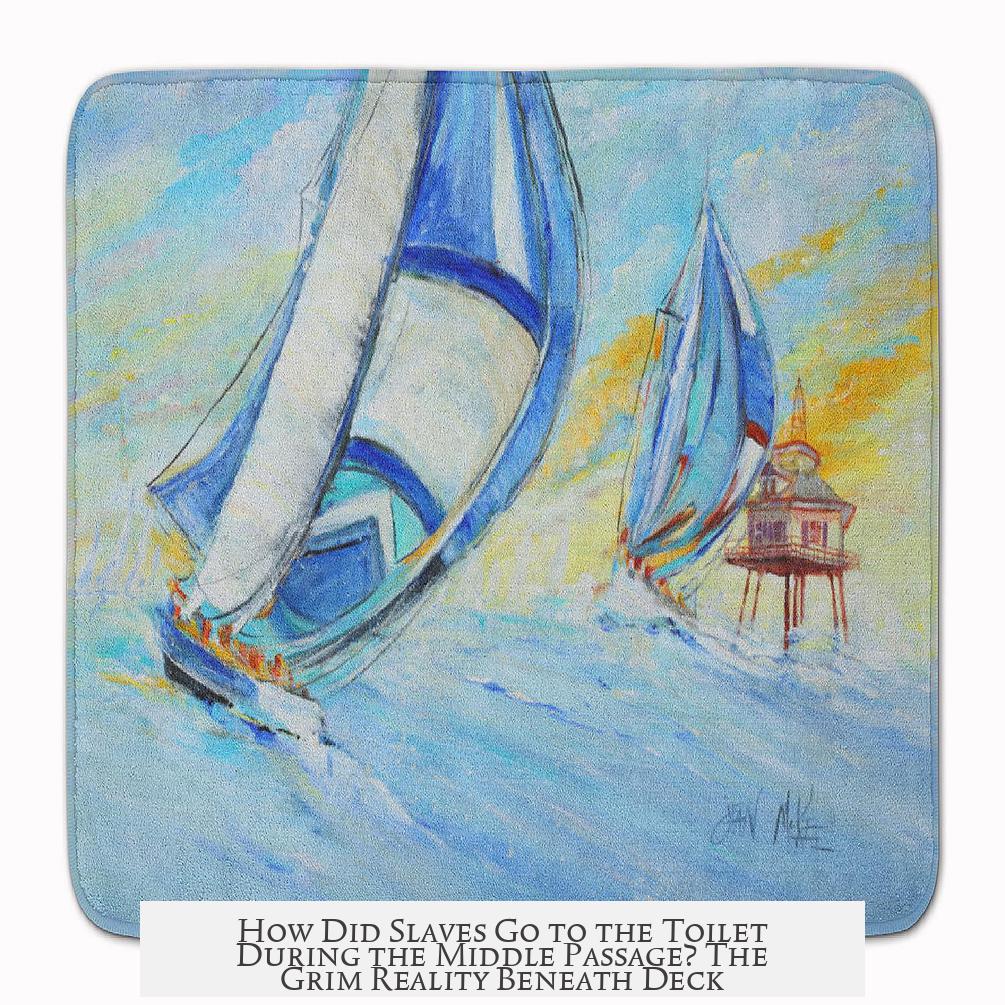During the Middle Passage, enslaved Africans had almost no proper facilities for toileting. Ships occasionally provided buckets for waste, but these were insufficient for the number of people aboard and the cramped conditions. As a result, many enslaved individuals urinated or defecated where they lay, sat, or stood, leading to extremely unhygienic conditions.
Ships transporting enslaved Africans were overcrowded. Men, women, and children were packed tightly into hold spaces where movement was limited or impossible. The scarcity of buckets meant waste disposal was irregular and inadequate.
Many enslaved people lay amidst their own excrement and urine. This created a breeding ground for disease. Dysentery, characterized by bloody diarrhea, spread quickly. The unsanitary environment contributed to sickness and high mortality rates on these voyages.
- Buckets existed but were too few.
- Tight confinement made waste disposal difficult.
- Many excreted directly where they were confined.
- Waste buildup led to unhealthy, disease-prone spaces.
The constant exposure to waste and lack of hygiene reflects the brutal conditions enslaved Africans endured. Their forced confinement during transport showed extreme neglect. The inhumane treatment undermined health and survival.
Ships’ crews often prioritized cargo over cleanliness. Limited effort was made to clean or separate waste. The result was an environment filled with human waste, worsening the suffering of those enslaved.
The Middle Passage remains a tragic chapter marked by dehumanization. The absence of proper toileting facilities symbolizes the disregard for enslaved Africans’ well-being during transport.
- Enslaved Africans had few or no toilet facilities.
- They often excreted in confined spaces where they lay or sat.
- This caused extreme filth and contributed to disease outbreaks.
- Dysentery was common due to exposure to waste and blood.
- Overcrowding prevented movement or proper waste disposal.
How Did Slaves Go to the Toilet During the Middle Passage? The Grim Reality Beneath Deck

So, how did slaves go to the toilet during the Middle Passage? The honest answer is: not well. Hygiene was a complete afterthought. Enslaved Africans endured brutal, inhumane conditions that few today can even imagine without recoiling. The ships were packed like sardine cans, but without any can of fresh air or sanitation.
Let’s dive into the grim details, not for shock value, but to truly understand the depths of suffering endured during this horrific chapter of history.
The Neglect of Hygiene
Imagine being trapped for weeks, sometimes months, on a filthy wooden ship, barely able to move. Hygiene was never a priority for the crew or shipowners. The health and dignity of enslaved people ranked at rock bottom on their list of concerns.
The captains and crew focused on cargo survival — not passenger comfort. That meant virtually no facilities were provided to deal with human waste properly. It was a brutal disregard rooted in racism and greed.
Toilet Facilities? Buckets and Buckets… or Not

Some ships had buckets designated for excrement. But here’s the kicker: the number of buckets was far too few. Enslaved Africans were crammed so tightly that reaching these buckets was often impossible. Picture hundreds packed shoulder to shoulder, lying or standing so close you couldn’t even straighten your arms.
With such tight confinement, many had no choice but to urinate and defecate right where they lay, sat, or stood. The “toilet” was the deck or floor beneath them. It was less a ‘facility’ and more a tragic consequence of captivity.
What Does It Look Like When People Live Among Their Own Waste?
The results were nightmarish. The enslaved lay amid a gruesome stew of urine, feces, and, in cases of dysentery, blood. You read that right. Dysentery tore through these cramped quarters regularly, turning ships into floating pestilence vessels.
Smallpox and yellow fever outbreaks thrived in this unsanitary chaos. Disease spread unchecked and killed many before ever reaching the Americas.
“Many lay there among each other’s urine, feces, and in case of dysentery, blood.”
The Psychological Toll: Madness, Revolt, and Escape Attempts

The physical misery translated into horrific mental anguish. Imagine sanity slipping away when packed so tightly, deprived of basic dignity. On many occasions, such conditions drove enslaved Africans toward madness.
Some chose to fight back, revolting whenever opportunity arose. Others saw only one escape: suicide. Jumping into the ocean at the first chance became a tragic, desperate act to regain autonomy over a life stolen from them.
Why Does This Matter Today?
Understanding the brutal realities of human waste management on the Middle Passage challenges sanitized versions of history. It forces us to confront the inhumanity enslaved Africans faced, beyond what typical textbooks mention.
It also highlights the resilience and strength of those who survived conditions that would break even the strongest today.
Lessons and Reflections

- Sanitation is a basic human right, yet it was denied to these individuals — reminding us of the essential nature of dignity.
- The psychological effects of neglect underscore how critical humane treatment must be in any form of captivity or imprisonment.
- The story emphasizes the urgent need to remember history fully, including its most uncomfortable truths.
Final Thoughts
The question of how slaves went to the toilet during the Middle Passage reveals a raw snapshot of the horrific neglect imposed on them. It’s a story of survival against all odds, where even the most basic bodily functions became weapons of oppression.
Next time you flush a toilet, consider this: millions once had no safe or clean way to relieve themselves while enduring the worst journey of their lives.
These details matter because they teach us the true cost of human cruelty and the enduring spirit of those who suffered. History isn’t just dates and battles; it’s the raw stories — no matter how grim — that shape who we are today.
How did enslaved Africans manage toilet needs during the Middle Passage?
Some ships used buckets for waste. However, space was limited, and many enslaved people had to relieve themselves where they stood or lay due to tight packing.
Were there enough facilities on slave ships for proper sanitation?
No. Buckets were often too few, forcing many to urinate or defecate in close quarters without proper disposal methods.
What conditions did slaves face because of poor toilet arrangements?
They often lay amid urine, feces, and sometimes blood from dysentery. This created severe health hazards during the voyage.
Did all ships provide the same toilet arrangements for enslaved people?
No. Some had buckets, but the cramped spaces made waste management nearly impossible on most ships.
How did the lack of proper toilet facilities affect the health of enslaved Africans?
Contaminated conditions led to outbreaks of diseases like dysentery, worsening the already brutal conditions of the Middle Passage.




